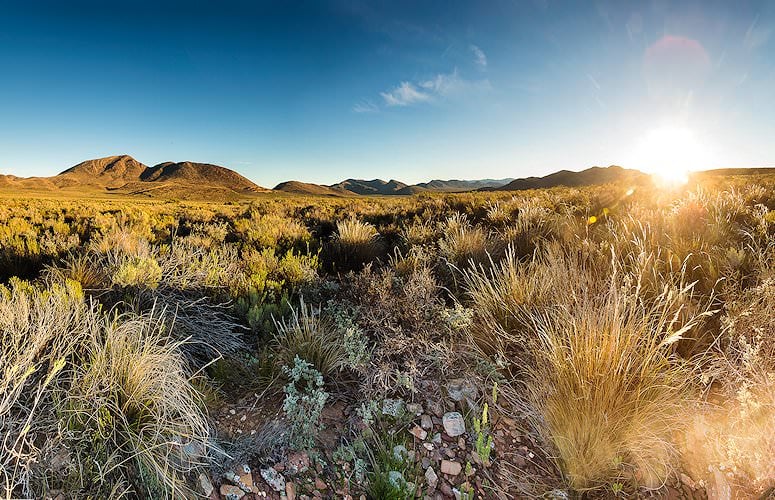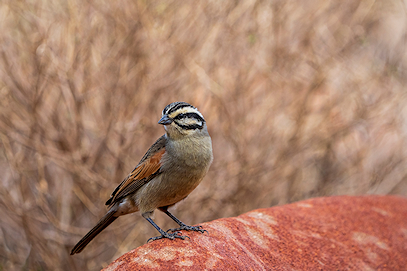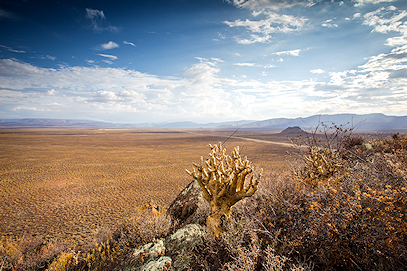-
Destinations

Top Destinations
Countries in Southern Africa
-
Our Private Tours

-
Safari Experiences

Popular Types
Safaris by Country
- Find a Trip
- About Us
- Start Planning
Tankwa Karoo National Park is situated on the southern boundary of the Northern Cape with the Roggeveld Escarpment to the east, Cederberg to the west, and Klein Roggeveld Mountains to the south. The park offers a unique safari experience in South Africa to those seeking an off-the-beaten-track adventure.
Need Advice?Only two Southern African regions have been bestowed the honor of designation as Biodiversity Hotspots by Conservation International. One is, of course, the Cape Floral Kingdom, and the other the Succulent Karoo.

The Tankwa Karoo National Park protects one of the most starkly beautiful tracts of the Tankwa Karoo and is well worth visiting for several reasons, amongst them its moon-like landscape, diversity of succulent plants, and fine Karoo birding. When taking a night drive, you may be surprised to find aardvarks in large numbers in the park. Though the remarkable endemism and diversity of the Succulent Karoo flora (at its most spectacular from August to October) is its most renowned aspect, the Karoo as a whole naturally has a great deal to offer the birder as well.
The park allows visitors to truly break away from their busy lives and enjoy an African safari experience in an area unscathed by civilization to a large extent. There are no restaurants, shops, or ATMs in the park. We will ensure you have everything you need before your arrival to enjoy your time - worry-free.
As the area is relatively far from any big cities, you will see the stars very clearly from this area. It is unlikely that you will ever again see the Milky Way, Orion's belt, or the Southern Cross as brightly and clearly as you will while star-gazing in this National Park. The Southern African Large Telescope (SALT) also lies in the Karoo, just outside the sleepy town of Sutherland.
The park does not offer any organized tours. Therefore, you can go on your expedition to look at the wildlife and birdlife and take in nature at whichever time you prefer, for as long as you want. African Sky will ensure you are always comfortable in an air-conditioned vehicle with an expert guide. There are also no official hiking routes, so that you can explore anywhere.
When visiting the Tankwa Karoo National Park, travelers will relish the otherworldly solitude and sheer nothingness. Far removed from the din of civilization, you will find your senses heightening, augmenting an appreciation for the smaller things.



The nearest airport to the Tankwa Karoo National Park is Cape Town International. Guests will be met at OR Tambo in Johannesburg and assisted with boarding a flight to Cape Town. The short flight offers a great view of the Karoo on a cloudless day, so try to sneak a peek out the window if you can. You will be driven directly to the park or your first tourist destination in the Western Cape from Cape Town.
The Great Karoo stretches hundreds of miles over central South Africa, and getting to the Tankwa Karoo National Park requires an almost 5-hour scenic drive from Cape Town, with magnificent views of the arid landscape. Guests will be transported to the park in an air-conditioned vehicle from either the airport or their previous tour destination.
The Tankwa Karoo is an arid area. The Word "Tankwa" is Khoisan for "land of thirst," – which should give you a good idea of the weather in this area. It is one of the driest regions in South Africa. Be sure to pack warm clothes, though - no rain does not mean it does not get cold in the area, especially in winter.
The days tend to get extremely hot, skyrocketing to almost 40 degrees Celsius in the summer months (December through February). During the winter, however, the temperatures drop, and once the sun sets, it can be freezing. The days are more comfortable than in the blistering summer months and less windy.
It is hard to believe that the Great Karoo once overflowed with water. Carbon dating and archaeological evidence have revealed that this area was a vast and fertile inland sea hundreds of millions of years ago. The Tankwa Karoo National Park was proclaimed in 1986 and added to the South African National Parks group portfolio. The conservation area has grown to about 146,373 from its original 27 064 hectares. The Bushmen first inhabited it, whereafter, the Khoe pastoralists entered the region. They moved their livestock in sync with the migration of wild animals.
In the 1700s, the Trekboers started appearing in the area, and ultimately, the landscape served as grazing pastures for their sheep. Cattle farmers also tried settling in the area, but the arid land was not ideal for their cattle to graze in. Overgrazing severely damaged the soil, and the park was not open to the public for the first few years. Ever since its proclamation, the conservation of endemic fauna and flora species has been the main concern for the park administration. South African National Parks prioritized this area by adding high biodiversity land and buying the surrounding farms to enlarge the conservation area to what is known today as the Tankwa Karoo National Park.
Smaller mammals, such as the steenbok and klipspringer, and larger antelope, including the Cape mountain zebra, grey rhebok, kudu, springbok, and eland, reside in the park and are most likely to be found in the eastern reaches. Various antelope species had to be reintroduced to the region to restore the natural ecology of the area and, in doing so, maintain its rich biological diversity. Radio transmitter collars were fitted to some of the animals, including gemsbok, red hartebeest, and springbok, to track and monitor the movements of the various groups.
This reintroduction program started in June 2004, with ten Cape mountain zebras, 114 gemsbok, 89 red hartebeest, and 170 springbok. A further 245 springbok and 60 eland were added between 2010 and 2012. An aerial game census of the Tankwa Karoo National Park in 2013 showcased the program's success by indicating that the animals had reproduced and spread over the entire park. You might even spot the elusive leopards that naturally roam the area if you're fortunate. Over 180 bird species also frequent the region. It is a favorite amongst birders because of the 18 endemic species. Birding buffs should also be on the lookout for the Verreaux's eagle.
The Tankwa Karoo National Park is situated in the Great Karoo, a vast semidesert ('semi' because it receives too much rainfall to be classified as a desert) that is sometimes also referred to as a 'friendly' desert. The area falls in the Succulent Karoo Biodiversity Hotspot, one of the 25 richest and most threatened reservoirs of plant life on earth. The Karoo and the park are home to the world's richest succulent flora.
Vegetation types include the Central Tanqua Grassy Plain, Roggeveld Shale Renosterveld, Tanqua Escarpment, Succulent Karoo, Roggeveld Karoo, Tanqua Wash Rivers, and Nieuwoudtville Roggeveld Dolerite Renosterveld. One of the most prominent aspects of the park is the remarkable endemism and diversity of the Succulent Karoo flora, with approximately 1 500 species that only occur in the Succulent Karoo biome. The vegetation is also one of the park's main attractions, especially after the summer rains when the various plants bloom.
The self-drive game drive is the most common activity at the Tankwa Karoo National Park. It allows you to observe various animals, bird species, and plants at your own pace. Make sure to get the list of animals and birds found in the park from reception so that you can know what to look out for and tick it off the list once you've seen it. There are also 4x4 tracks for the more adventurous, namely the Leeuberg 4x4 Eco-trail and the Watervlei 4x4 Route. Several other off-road tracks exist, but experienced off-road drivers should only attempt these. Luckily, the spectacular Gannaga Pass and Elandsberg viewpoints are easily accessible.
Bird watching is a popular activity, with the annual Tankwa Birding Bonanza held in the park every April. The Oudebaaskraal Dam is a popular spot for bird watching, especially for several waterfowl species. Altogether, 187 species of birds, of which 18 are endemic, so be sure to take your binoculars. If you enjoy hiking or cycling, you are more than welcome to engage in these activities inside the park. However, there are no official hiking or cycling trails, so be careful and stick to the marked roads for your safety. The vast landscape also offers excellent photographic prospects.